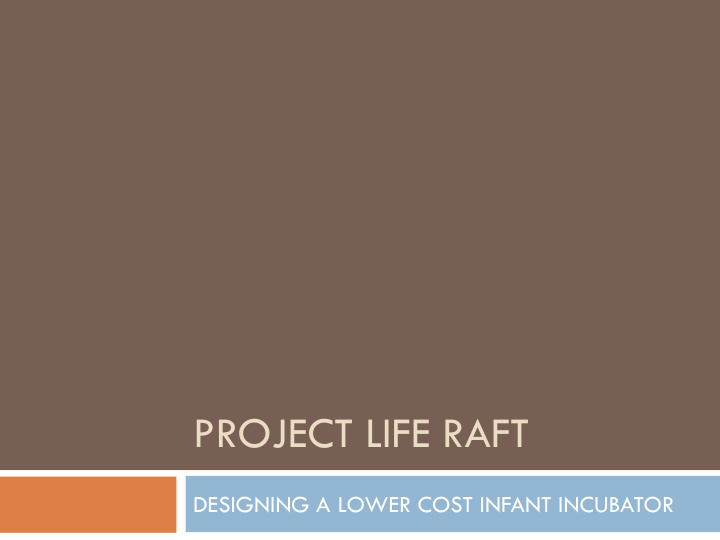



PROJECT LIFE RAFT DESIGNING A LOWER COST INFANT INCUBATOR
Project Goal: The goal of this project is to develop a functioning prototype of a low-cost incubator and isolation unit for infant care in developing countries, in collaboration with our project client Medicine Mondiale and the Kanti Children‟s Hospital in Nepal.
Goal of this visit The goal of this trip was to further the research done in January. Student teams had the opportunity to go deeper, in context. We‟re nearing the end of our observation phase… This trip‟s research will frame our next steps, guiding our brainstorms, prototyping, and finally our decisions for product features and functions.
Who We Met: We spoke with many stakeholders to understand needs and be inspired. We interviewed in context, for extended amounts of time. We visited 6 hospitals, meeting with directors, doctors, nurses, parents, and technicians.
What we learned Insights + Opportunities
Insight: Confusing incubators cost hospitals
Insight: Confusing incubators cost hospitals A district hospital has 5 incubators, but does not use any of them because the staff is afraid and confused by technology. Dhulikel Hospital nurse could not use built-in alarms because she can not read the German instructions. Scheer Hospital nurse did not use the humidity function controls because it was confusing to her. Maternity hospital experience with extensive maintenance needs of certain incubators cost the hospital money instead of enabling care.
Insight: Difficult to maintain incubators disables the NICU
Insight: Difficult to maintain incubators disables the NICU Repair times are often excessive. At Teaching Hospital an incubator was broken for one year until the biomedical engineer could travel to Delhi for a 50 rupee part. Several hospitals have no set budget for maintenance, and accessing any funds is time consuming. Complicated designs hinder maintenance for less experienced biomedical engineers and may require unavailable tools.
Insight: Shortcomings offer opportunity for improvement in functionality
Insight: Shortcomings offer opportunity for improvement in functionality Lack of appropriate sensors Teaching Hospital NICU‟s do not have the ability to monitor apnea (leading cause of incubator death) Need for multi-dimensional portability Premature baby in Dhulikel was carried outside from delivery room to NICU in winter Babies can die in transit to Kanti for a referral, wrapped in blankets--they could be saved with access to a transportable incubator. Lack of accommodation for basic procedures Most hospitals could not weigh babies inside the incubator; at Scheer this meant premature babies were removed from incubators, and at Dhulikel babies went un-weighed for days at a time.
Insight: Donated incubators often present difficulties
Insight: Donated incubators often present difficulties Antiquated temperature probe frequently detaches from skin in Kanti NICU, which can lead to overheating babies. Frequent maintenance problems and general unreliability with „Indian Incubator‟ has caused Maternity Hospital to blacklist similar products. Donated incubators often arrive at Teaching Hospital without manuals or parts.
Insight: Rural clinics present unique needs and constraints
Insight: Rural clinics present unique needs and constraints Dr. Sikarmi referred a premature baby for incubator treatment. Without a local incubator the child died 14 days later. “We need to manage locally”; with no local biomedical engineers, Dr. Sikarmi is responsible for all repairs. He has little access to parts, tools and information. 80% of births in Chautara vicinity take place at home. Premature babies sometimes die before reaching the clinic.
From these observations we began to understand the most critical user needs, and develop an understanding of ideal traits that we call design principles…
Design Principles Provides Reliable Climate Regulation Looks Sexy: Communicates Quality / Status Has Flexible Levels of Access Easy to learn / Hard to screw up Portable Facilitates Easy Maintenance Accommodates erratic/varied power sources Keeps Baby in Incubator as much as possible Affordable
The Journey of Care Administer Medication Check Vital Signs Change Diaper Feeding Discharge INCUBATOR Birth Weigh/Clean Diagnosis Surgery Weigh Phototherapy Clean Incubator Take X-Ray Going home!
The Journey of Care Administer Medication Check Vital Signs Change Diaper Feeding INCUBATOR CORE FUNCTIONS: Birth Weigh/Clean Diagnosis Discharge Maintain Heat, Isolation, Surgery Hydration, etc. Weigh Phototherapy Clean Incubator Take X-Ray
Next Steps: The field team will share what they have learned with our home teams. Additional synthesis, brainstorming, and prototyping sessions will take place over then next 10 weeks.
Next Steps: Also, we have identified many technical questions to be answered through medical literature. Just to name a few… How accurate does it need to be for temperature measurement? What‟s the complete range for temperature that you‟d want? What‟s the best location for the temperature probe? What‟s the best level of humidity? How does that change as the baby develops? Research apnea monitors.
Thank you
Recommend
More recommend